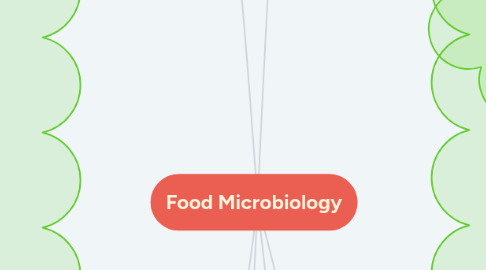
1. Food borne diseases
1.1. are acute illnesses associated with the recent consumption of food
1.1.1. classified
1.1.1.1. Food borne infections
1.1.1.1.1. are caused by the entrance of pathogenic microorganisms contaminating food into the body
1.1.1.2. Food borne intoxications
1.1.1.2.1. caused by
1.1.1.2.2. classified into
2. Hazard Analysis and Critical Control Points (HACCP)
2.1. is a proactive prevention-oriented program that addresses food safety
2.1.1. Principles
2.1.1.1. 1- Conduct a hazard analysis
2.1.1.2. 2- determine the critical control points (CCPs) in the process
2.1.1.3. 3- Established critical limits for preventive measures associated with each identified CCP
2.1.1.4. 4- establish CCP monitoring requirements and monitor the CCPs
2.1.1.5. 5- establish corrective action to be taken when monitoring indicates that there is a deviation from an established critical limit
2.1.1.6. 6- Establish procedures for verification that the HACCP system is working effectively
2.1.1.7. 7- Establish documentation of all procedures and records appropriate to these principles and their application
3. Testing Foods for pathogens
3.1. Food Quality control is the multidisciplinary approaches of maintaining physical, chemical, microbiological, technological and sensory in foods
3.1.1. Polymerase Chain Reaction – Restriction Fragment Length Polymorphism (PCR-RFLP)
3.1.2. Random Amplified Polymorphic DNA PCR (RAPD-PCR)
3.1.2.1. advantages
3.1.2.1.1. Pure DNA is not needed
3.1.2.1.2. Less labor intensive than RFLP
3.1.2.1.3. There is no need for prior DNA sequence data
3.1.3. Ribotyping
3.1.4. Plasmid Profiling
3.1.5. Lab-On-A-Chip technology
3.1.6. Direct Epifluorescence Technique (DEFT)
3.1.7. Electrophoretic methods
3.1.7.1. isoelectric focusing (IEF)
3.1.7.2. urea isoelectric focusing (urea-IEF)
3.1.7.3. sodium dodecyl sulphate – polyacrylamide gel electrophoresis (SDS-PAGE)
3.1.7.4. two dimensional electrophoresis (2DE)
3.1.7.5. capillary electrophoresis (CE)
3.1.8. Biosensor
3.1.9. Impedance-based biochip sensor
3.1.9.1. Based on the changes in conductance in a medium
3.1.9.2. Allows the detection of only the viable cells
3.1.10. Piezoelectric biosensor
4. ESRA FARAJ ALGHAMDI - 1614757 - ZAR
5. Food preservation
5.1. Inhibition priciple
5.1.1. water activity
5.1.1.1. Add high salt
5.1.1.1.1. Sodium chloride
5.1.1.1.2. nitrats and nitrites
5.1.1.2. Add high sugar
5.1.1.3. Drying
5.1.1.3.1. air drying
5.1.1.3.2. electrical drying
5.1.1.3.3. freeze drying
5.1.2. pH
5.1.2.1. fermentation
5.1.2.2. addition of acids
5.1.3. preservatives
5.1.3.1. sodium benzoate
5.1.4. low temperatures
5.1.4.1. chilling
5.1.4.1.1. 0 - 15oC
5.1.4.2. freezing
5.1.4.2.1. 0oC - -35oC
5.1.5. Smoking
5.2. Killing principle
5.2.1. Heat treatment
5.2.1.1. pasteurization
5.2.1.1.1. Low temperature long time (LTLT) > 63oC for 30 min
5.2.1.1.2. High Temperature short time (HTST) > 72oC for 15 seconds
5.2.1.1.3. ultra-heat-treating (UHT) > 140oC for 4 seconds
5.2.1.2. sterilization
5.2.1.2.1. Heating
5.2.1.2.2. Irradiation
5.2.2. Irradiation
5.2.2.1. gamma rays
5.2.3. Use of gases
5.2.3.1. ethylene oxide or ozone
6. Food spoilage
6.1. damage or injury to food which becomes unsuitable for human consumption
6.1.1. Types of spoilage
6.1.1.1. Microbial spoilage
6.1.1.1.1. Baterial soft rot
6.1.1.1.2. Anthracnose
6.1.1.1.3. Black mold rot
6.1.1.1.4. Gray mold rot
6.1.1.1.5. Rhizopus soft rot
6.1.1.1.6. Alternaria rot
6.1.1.2. Non-Microbial spoilage
6.1.1.2.1. Chemical spoilage
6.1.1.2.2. Biological spoilage
6.1.2. Causes of food spoilage
6.1.2.1. Growth and activity of microorganisms
6.1.2.1.1. Ex.
6.1.2.2. Enzyme activity
6.1.2.3. Chemical reactions
6.1.2.3.1. Ex.
6.1.2.4. Vermin
6.1.2.4.1. Ex.
6.1.2.5. Physical changes
6.1.2.5.1. By
6.1.3. Sources of microorganisms in food
6.1.3.1. Soil and water
6.1.3.2. Plant and plant products
6.1.3.3. Food utensils
6.1.3.4. Intestinal tract of man and animals
6.1.3.5. Food handlers
6.1.3.6. Animal hides and skins
6.1.3.7. Air and dust
6.1.4. Factors affecting microbial growth in food
6.1.4.1. Intrinsic factors
6.1.4.1.1. pH
6.1.4.1.2. moisture content
6.1.4.1.3. nutrient content
6.1.4.1.4. antimicrobial substances
6.1.4.1.5. biological structures
6.1.4.2. Extrinsic factors
6.1.4.2.1. Temperature of storage
6.1.4.2.2. Presence and concentration of gases
6.1.4.2.3. Relative humidity

